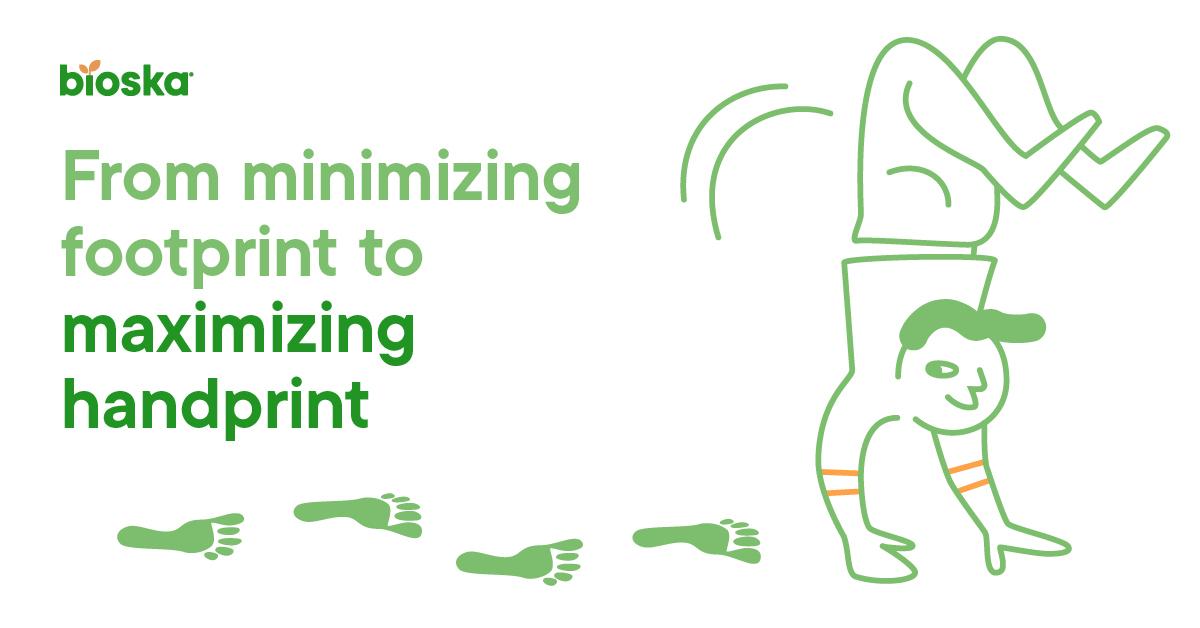While sustainable goals take off in the packaging world, we pledge for moving beyond simply thinking about the environmental footprint to also consider the positive handprint of the material you are wrapping your products in.
Taking the path less traveled
As the demands for sustainability grow, companies across sectors typically choose one of the two alternative paths. Path One: Companies focus on improving their existing processes to minimize some of the harms their businesses are linked to. We call this as Minimizing the Footprint. Path Two: Companies leverage their core business to produce profitable solutions to the problems of the people and the planet. We call this as Maximizing the Handprint.
Simply put:
Path One: Footprint recognizes the bad stuff. It can, and should, be reduced to zero.
Path Two: Handprint captures the good stuff. It can grow, at least in theory, infinitely.
While Path One still encapsulates much of today’s business sustainability, we, at Bioska, strongly believe in taking the path less traveled. And we would like to bring you along. Of course, we continue to reduce our footprint, but at the same time we can help you reduce yours, which then becomes our handprint. And when you do the same to your customers, it then becomes your handprint. Following this path further, your handprint can grow even bigger than your footprint.
Which one you think will be the winning strategy for businesses in the next 5 years?

Being part of the solution
“If I had thrown a trash in the park every day and one day woke up to the fact that there is too much trashes in the park, the problem cannot be solved by only throwing trash in the park every second day.” (Antero Vartia, the founder of Compensate)
This quote illustrates well why it is not enough that we only reduce our misbehaviors or negative impacts but why we need to focus on creating significant positive impacts in critical and relevant areas for society. This shift In our mindset moves beyond analyzing sustainability problems to finding sustainable solutions.
Until recently, many companies have used to think and measure their environmental performance through the negative impacts such as carbon emissions, produced waste or the use of harmful materials. But exceedingly, we also see more and more companies that do lots of good things that are improving the environmental performance of their own, but also that of their clients and other stakeholders. To conclude, handprints can be used for demonstrating these improvements.
For a long time, the problem was that we were lacking a proper methodology on how to calculate these positive improvements. No longer, as the Finnish Research Institute VTT run a two-year project (2016-2018) that created a methodology for carbon handprint calculations. Next, the methodology is expanded to other handprint calculations. Kudos to science!
Materialising the shift
With consumers demanding more from packaging companies, and consumer packaged goods companies setting sustainable packaging goals tied to 2025, it seems the right time for this shift in thinking.
Since 1997, Bioska has helped its clients and consumers to recycle biowaste so that produce could rejoin the cycle of nature. Continual advancements in raw materials have enabled us to develop all kinds of new applications to our technology. By running experiments with our customers, we have learned which applications are the most useful, and where we can grow our own handprint even further.
One topical example are the fully compostable Walki®Bioska agricultural films and substrates for open fields and greenhouses. The agricultural films, which decompose with the help of soil microbes, challenge the plastic covers traditionally used in the fields. By replacing traditional plastic covers, Bioska increases its handprint by helping farmers to decrease their environmental footprint. The films also increase plant productivity by raising soil temperature and preventing moisture evaporation, all while using less pesticides. And using them also saves labor costs in fields and greenhouses. So, it is a true win-win situation for the farmers and the environment alike. You can read farmers’ experiences about using these films from the Finnish article ‘Maatuva katekalvo säästää työtä ja luontoa’.
With this in mind, we suggest that footprints are only half the picture. The other half is just coming into view. Raise your hand, if you are willing to think and measure the positive impacts that we all can make.
